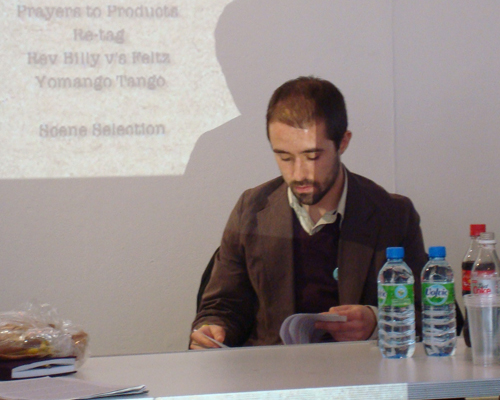Ask a question about art and it will invariably lead to more questions, most of which will either be unanswerable or, at best, debatable.
Kicking off the Lincoln Art Programme was a panel debate at the Greestone Centre, which discussed the relevance of “art-jacking” as a form of live art. The debate went to the core of art-jacking: What is it? Is it art, theatre, or entertainment? Is it political protest or anarchy? The debate left us none the wiser, but perhaps that was the point.

art-jacking is live art taking place in public arenas. It is similar to street theatre, except that it is unexpected and uninvited. It is performed by artists instead of actors, making it bad theatre, and arguably bad art.
It could take the form of a mock protest in a supermarket, clowns in McDonalds, or actors worshipping mannequins in House of Fraser. It could be political graffiti. Alternatively it could be the Reverend Billy, dressed as an American evangelical preacher and looking like a “cartoon James Brown”. Followed by his “choir” he performs in places such as Leicester Square, apparently decrying the anti-capitalist cause but also just “being” live entertainment.
The debate centred on the question of whether art-jacking alienates or empowers its audience and focussed on the idea of art-jacking as political protest. Hugh Dichmont, an art journalist, and Lawrence Bradby, an artist and curator, argued that art-jacking alienated its spectators.
Meanwhile, Lois Keidan, director of the Live Art Development Agency, and Ana Benlloch, also an artist and curator, argued it empowered them, contending that as political protest, live art engenders discussion and makes people think about current issues. However, is it enough that a spectator is made to think about a political issue, especially when it is dressed up in such quirky style?
Dichmont and Bradby argued convincingly that it wasn’t. In fact, the sight of art students in Tesco shouting slogans, or in John Lewis painting themselves with make up testers is more likely to embarrass and annoy those unwilling spectators.
They argued that this type of art as protest can also be dangerously counter-productive, putting people off an otherwise valuable cause. It is patronising to take a serious issue and turn it into a frivolous and ephemeral showpiece. Artists need to stop pretending their art has value as political commentary and remember that the only value it has is intrinsic. Art as protest is poor and unconvincing — art for the sake of art is preferable.
Bradby gave the most valid criticism: as it is unexpected, the spectator has no frame of reference in which to “view” the art, and if art has no context then it has no meaning.
In art-jacking the audience is not aware the art is taking place, and so they can’t engage with it. Ultimately it is like amateur dramatics: the artists have great fun themselves, but at the expense of everybody else. Artists need to realise that just because they say something is art, it doesn’t mean it is.

I agree 110% with everything you said!
Just because they say something is art, it doesn’t mean it is. and just because something that is displayed is weird doesn’t mean it’s art.